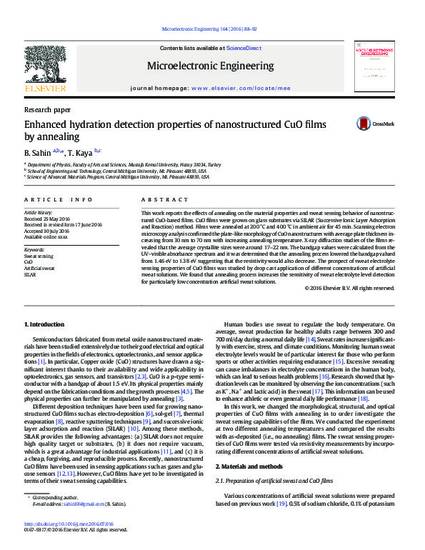
Article
Enhanced Hydration Detection Properties of Nanostructured CuO Films by Annealing
Microelectronic Engineering
(2017)
Abstract
This work reports the effects of annealing on the material properties and sweat sensing behavior of nanostructured CuO-based films. CuO films were grown on glass substrates via SILAR (Successive Ionic Layer Adsorption and Reaction) method. Films were annealed at 200 °C and 400 °C in ambient air for 45 min. Scanning electron microscopy analysis confirmed the plate-like morphology of CuO nanostructures with average plate thickness increasing from 30 nm to 70 nm with increasing annealing temperature. X-ray diffraction studies of the films revealed that the average crystallite sizes were around 17–22 nm. The bandgap values were calculated from the UV–visible absorbance spectrum and it was determined that the annealing process lowered the bandgap valued from 1.46 eV to 1.38 eV suggesting that the resistivity would also decrease. The prospect of sweat electrolyte sensing properties of CuO films was studied by drop cast application of different concentrations of artificial sweat solutions. We found that annealing process increases the sensitivity of sweat electrolyte level detection for particularly low concentration artificial sweat solutions.
Keywords
- Sweat sensing,
- CuO,
- Artificial sweat,
- SILAR
Disciplines
Publication Date
2017
DOI
https://doi.org/10.1016/j.mee.2016.07.016
Citation Information
B. Sahin and T. Kaya, “Enhanced Hydration Detection Properties of Nanostructured CuO Films by Annealing,” Microelectronic Engineering, 164, 88-92, 2016 (Impact factor: 1.4).
